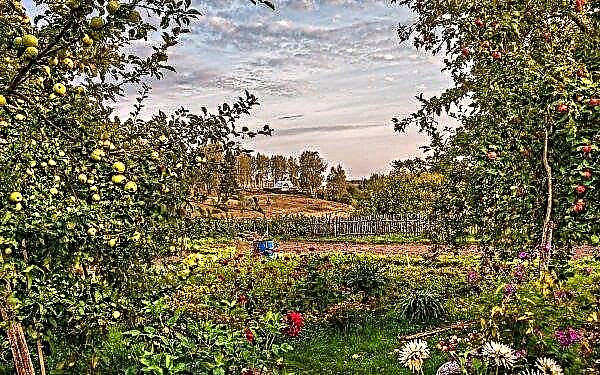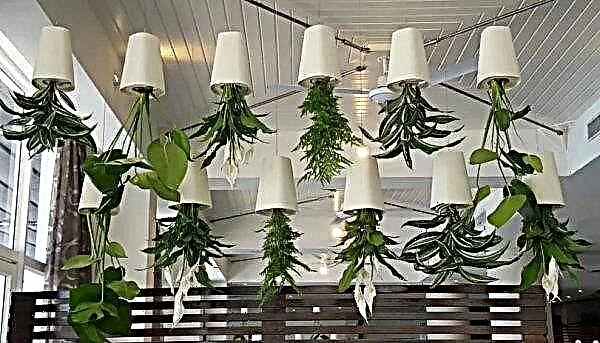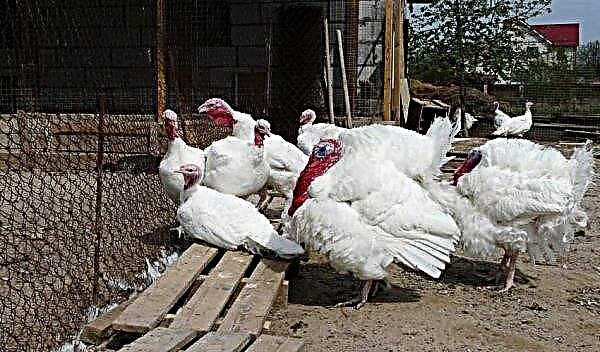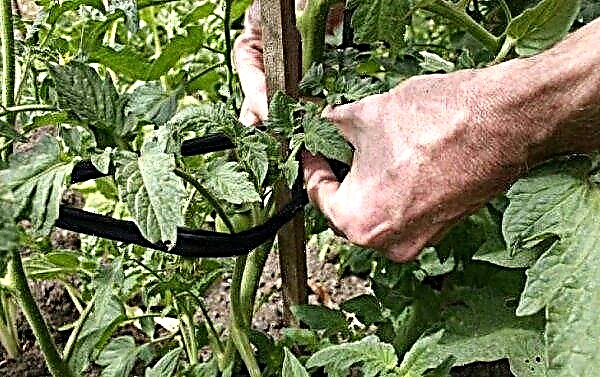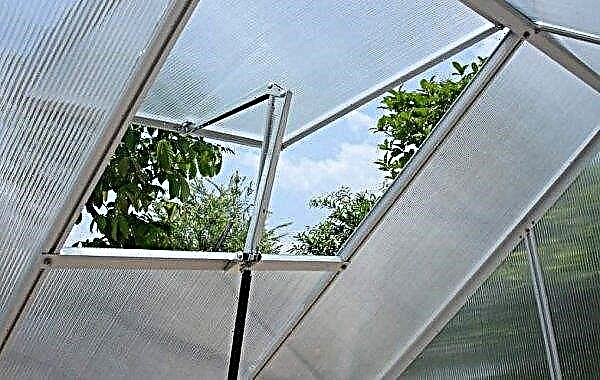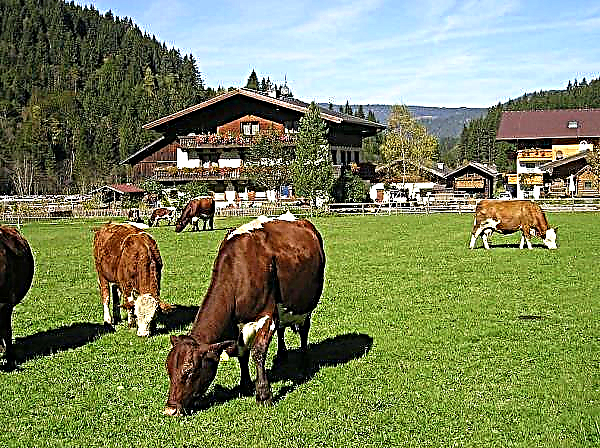The beauty of the majestic flower arrows of gladiolus has provided this amazing plant with high interest from breeders and the inexhaustible love of gardeners. In the world there are about 5 thousand of its brightest varieties, and the figure is increasing every year. Some varieties are leaving, new, but elegant sophistication of the species-specific Prague, has been appearing for a decade now, as it occupies an honorable place in the collections of experienced gardeners and amateurs.
Botanical grade description
Registered in the catalog of the Variety Register of Moscow and St. Petersburg Club of gladiolus growers under the code 475, the gladiolus Prague, blooming for 75–79 days, from July to September, was presented to the world-famous Russian breeder V.P. Fotin in 2011. ., and to this day remains one of the most sought-after among enthusiastic selection people, and among fans of beauty flower beds.

The exotic color is enclosed in a gradient from light lilac to raspberry-lilac color, which is more pronounced to the edges of the petals. There it acquires a saturated pink tint with greens.
Lilac touches are visible in the throat of the flower, its inner petals are pink-lilac, and wide fringing reflects light green-green tints with gray-green blotches.
Prague is distinguished by dense multicolor inflorescences with pronounced corrugated large folds and voluminous pinches, which are interspersed with small ones near the end of a fragile petal. A pronounced relief of small folds is also observed on the inner petals; their outer edges end in a light fringe.
The xiphoid leaves at the root are dense, painted in intense green color, grow to a length of about 85 cm. The stem is single, does not break under the weight of the arrow.
Important! When growing hybrid varieties, keep in mind that the characteristics of the height, quantity, size and simultaneous dissolution of inflorescences on the ear can change with changing growing conditions and climate.
The given botanical features of the Prague variety are recorded in the generally accepted classification system when added to the register:
- cipher: 475;
- variety name: Prague
- the class: large-flowered (400);
- Colour: light pink-lilac (70–78);
- flowering period: early middle (RS);
- year of introduction: 2011;
- originator: Fotin V.P .;
- registered: Fotin V.V .;
- degree of corrugation: corrugated (G);
- the number of buds in the inflorescence: 23 pcs.;
- number of simultaneously open flowers: 8-9 pcs.;
- flower diameter: 11.5 cm;
- plant height: 125-130 cm;
- spike length: 70 cm.
It should be noted that in English catalogs, and, as a consequence, in the assortment of online stores and garden centers, one more corrugated variety from the Netherlands is often found, under the code 445, with the same name - Prague. There are commercial names for this product - Floss Florium and Olympic Flame.

Be careful: English spelling looks different - Praha. It is distinguished by its color group and some varietal features: not very large flowers with juicy pink and salmon petals in peach tones and a bright yellow neck and green border, blooming, become like a butterfly. Therefore, this species is assigned to the group of contrasting undersized gladioli Butterfly and is not related to the popular variety of Russian selection from the group of large-flowered. Information about the origin of the hybrid and its originator will help to avoid confusion.
Why is it called
According to the testimony of the breeder’s son, Fotin V. V, who for 20 years has been successfully continuing to develop his father’s unique achievements, they give names to new varieties associatively. A trip with the whole family to the Czech Republic with subsequent impressions inspired this name. The flower gives memories of the warm rays of the setting sun against the evening, lilac and in some places still turning blue sky, which glide along the crimson tiles of Prague roofs with rich illumination, flashing here and there with green and yellow glare of igniting windows.
The same magic happens when you first look at blooming Prague: like the Czech capital, which gave the name to this variety, it captivates and beckons with a mysterious aura of the amazing charm of sunset in twilight.

The use of flower in landscape design
Florists appreciate graceful Prague and often use it in cutting compositions, this variety is also popular when creating garden layouts by landscape designers.. Despite the increased requirements for the care of gladioli, they admirably decorate flower beds and mixborders.
With gladioli it is worthwhile to show moderation in quantity and palette so as not to oversaturate the landscape. Do not rush to extremes: one single specimen looks wretched, while a large number will turn the garden into a flower plantation.
In recent times, gladularia - flower beds where exclusively gladioluses grow - are becoming fashionable.. When compiling them, it is necessary to take into account the timing of flowering of different varieties and an organic combination of colors. Combine early, middle, late varieties - this will help to create whole patterns from these self-sufficient flowers, pleasing with bright colors throughout the summer. The correct arrangement of color accents in a less bright frame will help to avoid grudges to create a harmonious composition.
Did you know? In European countries, the presented bouquet of gladioli expresses a desire to support the recipient in case of radical changes in fate and in making important decisions.
When choosing satellites for gladiolus, consider the time of flowering to avoid voids in spring and autumn. Take care of the ratio of their height - undersized plants with lush foliage will successfully cover the tall stalk. In the spring it can be hyacinths, tulips and daffodils. The beginning of summer will be marked by the flowering of low fragrant peonies, lovely daisies and catchy irises. The low daylilies will successfully cover the gladiolus with foliage and single flowers, which from mid-summer until September will take turns revealing chic inflorescences.

The optimal amount for creating an expressive color spot will be 10-15 bushes. When choosing varieties, remember that several two- and tricolor varieties planted nearby can look tasteless and get lost in the overall picture. Place these separately from each other, then the beauty of the combination of tones will be fully revealed. Hybrids with small flowers will lose to large-flowered ones, which will draw all the attention to themselves.
The color scheme may be different, but the transition of colors - smooth. Avoid dahlias: the rivalry of proportional, bright, blooming neighbors at one time looks too colorful, killing the beauty of the background. In autumn, hydrangeas and chrysanthemums will decorate the plot. From a practical point of view, placing annuals near is convenient - the roots will not hurt when digging bulbs for the winter.
The background for gladioli should be uniform in structure and color, it will be composed of perennials: shrubs of spirea, barberry or coniferous trees look organic and discreet canvas for a spectacular explosion of colors. The foreground skewers will yield to the soft texture of undersized heicher and variegated host. Junipers and textured stones next to it emphasize the natural wildness of the mixborder and set off the royal luxury of the skewer flowers. Spicy herbs, such as sage, oregano, ruta, tobacco, and small-flowered species such as phlox, zinnia, lavenderia, snapdragon, perfectly complement the composition.
Not suitable for landing in borders on Prague, where only low-growing varieties of skewer look great. It is the curb group of gladioli that is used in the design of paths along the lawns. But when planning a fence (rectangular lawns) or a place at the entrance to the site, this tall variety, planted with a narrow strip, becomes indispensable. You can combine shades, add decorativeness, alternating planting with shrubs with bright foliage and medium-sized flowering plants.
Did you know? The Middle Ages was distinguished by a reverent attitude towards floriculture and cruelty to wrecking in the gardens: a shameless pillar or even expulsion from the city was expected to destroy the alien flower garden.
Whatever place you choose for Prague, it looks best in the second or third row. To enhance the effect, plant the bulbs tightly, then this variety will become the main emphasis on the flower bed. It is worth taking care of the support for a heavy flowering stalk and disguising it with stunted annual flowers or bindweed.
Flower planting
At first glance, planting bulbs does not cause trouble. But do not neglect the basics of agricultural technology of gladioli, which are considered demanding colors in matters of cultivation. Knowing its features will save you from many problems in the future.
Professionals in the cultivation of gladioli prefer to take for planting large premium bulbs with a diameter of 14 cm or more. Such specimens take root and germinate faster, and plants from them turn out stronger, higher, with an extended flowering period.
Video: Planting gladioli
Not always a large bulb gives a guarantee of luxurious flowering. Planting material must be young and not infected with fungal, viral, bacterial diseases.
Tuber age is determined by two main parameters: bottom size and height. With age, the donut becomes large, and the corm is flat. From old copies of this form, a magnificent bouquet will not work. But when using hybrid variants of gladioli, compare the type of corms with the same grades - planting material of different varieties can differ markedly.
Important! Gladioli develop better after predecessors such as dahlias, marigolds, zinnias, peas, beans, garlic, and onions. Avoid when planting flowers after asters, cabbage and root crops.
Landing time
Two weeks before the proposed landing, somewhere in late March, it is necessary to sort out all the overwintered planting material and carry out the necessary preparations for planting, taking into account the dates:
- Remove all diseased and partially stained rotted bulbs. Carefully clean the adult bulbs from hiding scales, being careful not to damage the hatching sprouts.
- A single treatment with any stimulants of growth and root formation (Epin, Cornevin, Heteroauxin, Zircon, etc.) will be beneficial. Soak the planting material for 5–10 hours in a solution prepared according to the instructions, then dry for about a day.
- If you suspect an infection with insects, spray the entire volume with the preparation "Aktara" or "Decis" according to the instructions.
- To accelerate forcing in the northern regions, 1-2 weeks before planting (from mid-April), lay out in one layer all healthy specimens in a warm (+ 30 ° C), light, not very humid (up to 60%) place, sprouts up. By the time of transfer to the ground, the shoot length will increase to 5–7 cm.
- To completely get rid of potential pathogenic factors, immediately before planting, soak the bulbs in a solution of systemic fungicides for 1-2 hours. Suitable drugs are "Maxim", "Fundazim" (50 g per 2 liters of water), "Fundazol" (10 g per 10 liters of water). For the same purposes, you can do soaking in a solution of potassium permanganate (0.5%), this will protect them from soil infections.
- Clean the kids before the planting process itself.
- After 9-hour treatment by immersion in a solution of potassium permanganate (0.5 g per 1 liter of water), corms can be transferred directly to the well without drying.
- Very large bulbs cut in half between the ledges with sprouts for rejuvenation and good growth in the future. Sprinkle the cut sides with wood ash, dry cinnamon powder or crushed activated carbon.

In late April and early May, planting can be carried out, making sure that the soil is warmed up to +8 ... + 10 ° C 10 cm deep. The exact time depends on the weather and climatic conditions of the region: if you can plant in the middle lane in April, then in Siberia, for example, it is impractical to start earlier than May 1–10. Keep in mind that being late with a planting date is unfavorable for the development of the plant: the soil can lose moisture, which will delay the flowering of gladioli.
Important! Germination of tubers will accelerate after soaking in any growth stimulator, while the concentration should be half as weak as for adult corms.
How to plant
A heated area with plenty of sunshine, lack of soil moisture, good air access and wind protection is dug up before planting gladioli.
Loose soft earth and compliance with planting conditions are a guarantee of the correct development of bulbs:
- Only fertile soil is suitable for planting. Choose the area where chernozem, light loam or sandy loam is present at an acidity of 6-7 pH.
- Excessive moisture in the soil will lead to the death of the skewer: the topography should be even, a slight slope of not more than 5 ° towards the south will eliminate excess water. With a high position of groundwater and the location of the flower beds in the lowland, additional drainage is necessary for outflow.
- For flowering to last, plant a gladiolus so that direct rays do not fall on it in the afternoon. In this case, flowering will last: the lower flowers will not fade so quickly, while the upper ones will gradually bloom.
- Dig a row or individual holes with a depth of 20 cm, add 1-2 cm of river sand to the bottom to protect the delicate roots. Moss can replace the sand at the bottom of the hole, it will prevent the development of rot and save moisture in the heat.
- Pour a furrow or a landing hole with a solution of potassium permanganate of dark raspberry color.
- The distance between plants of large varieties should be at least 40 cm, between rows 20-25 cm.
- Vary the location of the future bush in a row according to personal tasks, ease of care, depending on the power of the variety and the size of the bulb. It is permissible to plant children denser. Especially valuable varieties, give the best places for accelerated reproduction.
- Place an adult corm on the size of 3 cm or more in the recess at three heights, which will be approximately 15–20 cm. Children need a shallower depth, 5–10 cm recesses will be enough for them. With a small planting, the stem will fall, with a deep one, the gladiolus will not release color.
- Top the onion with a 2-cm layer of sand, then cover with earth.
- To preserve moisture, mulch the landing site with straw, sawdust, old humus, and needles.

Flower care
The plant responds well to regular care and does not require any special procedures.
If you want it to bloom fully on time, follow the recommendations of experienced gardeners:
- Weeding and loosening will facilitate oxygen access to the roots.
- Feeding is carried out at least 4 times per season. At the beginning of the growing season, after the appearance of the second leaf, organic matter is added (15 l of manure per 3 m²), with growth, nitrogen fertilizers are used to feed the foliage. Use urea, ammonium nitrate (30 g per 1 m²). Potash and phosphorus fertilizers will be needed twice during budding and flowering (40 g of superphosphate, 30–35 g of potassium sulfate per 1 m²).
- The length of the roots reaches 35 cm, so once a week after sunset, water the plantings with a sufficient amount of water (15 l per 1 m²). In the heat, the frequency of watering must be doubled, after which it is imperative to loosen and mulch the earth.

- Regularly discard and destroy diseased bushes directly from the ground, and then treat the soil with a solution of “Fundazole” (10 g per 10 l of water) or potassium permanganate (10 g per 10 l of water).
- Spraying will be needed to control pests and diseases that can be combined.Perform the treatment only after irrigation in non-hot (below + 30 ° C) weather, without direct rays, with dryness and calm weather. Mix the Fitosporin solution with the Decis, Actellik, and Fury insecticides.
- The taller the skewer, the more he needs support. Tie up the flower stalks at the moment the buds are formed, then the severity of the flowers will not break the stem.
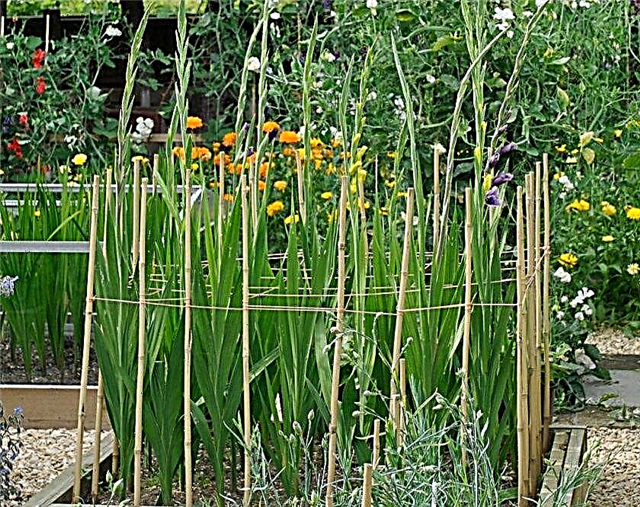
- In the northern regions and on the slopes, you may need a protective wings from the winds that harm the gladiolus. A solid wall of the fence will serve as such an obstacle.
- Dig gladioli from mid-September, 35–45 days after flowering. Lastly, remove the corms that grew from the baby.
- After digging, it is necessary to clear the soil and soak the corms for half an hour in a solution of potassium permanganate (10 g per 10 l of water), Fundazole or Maxime, then immerse it in a Decisa solution (1 ampoule per 5 l of water for 30-40 minutes) ) Dry for two weeks at a temperature of + 25 ° C, and the next 2 weeks at room temperature (+18 ... + 21 ° C), after which you can lay it for winter storage.
- Store corms at a temperature of +3 ... + 10 ° C, the lower shelf of the refrigerator will do, a dry cellar.
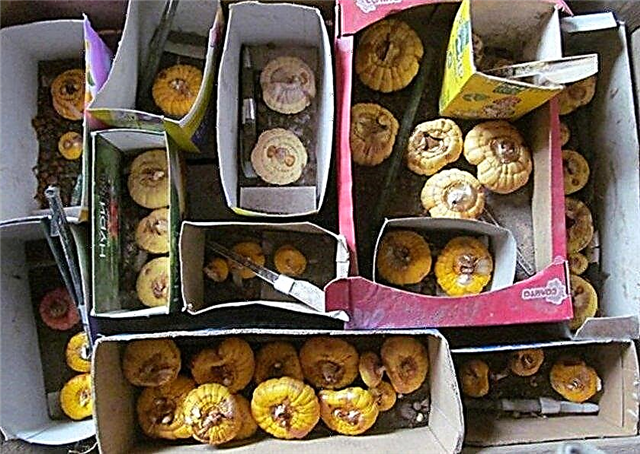
- Do not plant gladiolus in the same place for more than two consecutive seasons.
- Changing the landing site, take care of changing the quality of the soil. From light chernozem suitable landing in sandy loam.
Did you know? There are no snow-white flowers, there are colorless — without coloring pigment, they reflect sunlight. There is no black in their color — the apparent color is actually dark red or deep purple.
The grace and charm of gladioli in correctly composed mixborders is undeniable, but the charm of the Prague variety will give the flowerbed a truly unique look, complementing the impression with a fresh aroma. Use it to cut to the celebration or as a manifestation of love - it is difficult to resist such a sign of attention.






